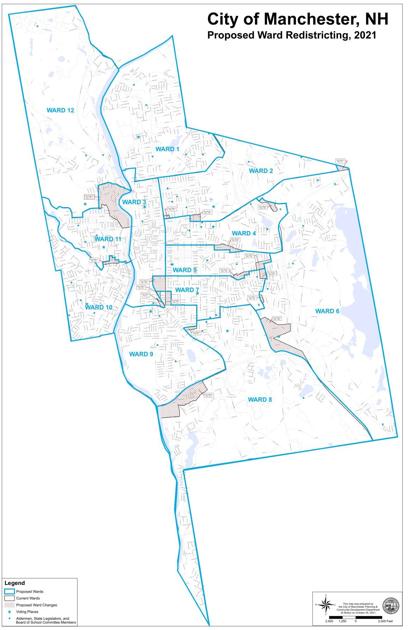
Manchester city planners are recommending that ward boundaries be adjusted due to population changes reflected in the 2020 Census.
Aldermen are scheduled to review a report on proposed redistricting changes to the city’s 12 wards when they meet Tuesday at 7:30 p.m. at City Hall.
Redistricting is the process of redrawing the boundaries of legislative districts, such as aldermanic wards.
Section 5.33 of Manchester’s charter requires that the city be divided into 12 wards of equal populations, or as equal as practicable. The Board of Mayor and Aldermen are required to review ward boundaries every 10 years upon release of the federal census figures, or as necessary to conduct fair elections, pursuant to the state Constitution.
On Aug. 12 and Sept. 16, the U.S. Census Bureau released its redistricting data.
The Census Bureau found that the 2020 population of Manchester was 115,644, up 5.5% from the 2010 population of 109,565.
Figures show the change in population was not evenly distributed among the wards. For example, Ward 2 gained the least number of people (73), while Ward 12 gained the most people (1,012).
As a result, the population of the wards has become more unequal since the redistricting performed after the 2010 Census. After 2010, the difference between the most populous and least populous wards was 269 people. Currently, the difference is 867 people.
According to city planner Jeffrey Belanger, the rule of thumb that the New Hampshire Supreme Court has used to ensure that a redistricting plan meets the constitutional requirements for equality is 10% total deviation from an ideal district, defined as the average of the population and the number of districts.
The second step is to find the relative deviation of each voting district from the ideal district. That is done by dividing the difference between the district’s population and the ideal population and dividing that by the ideal population.
According to Belanger, if the ward boundaries were left as they are, the total deviation of population from the ideal ward would be 8.99% — under the 10% maximum population deviation considered constitutional.
“Although leaving the ward boundaries as they are would be within constitutional limits, it would be close to them,” writes Belanger in a memo to city aldermen. “If Manchester’s population were to increase along the same trends, more inequality would result.”
City planners recommend aldermen redistrict the ward boundaries.
“Doing so would create more equal voting weight among Manchester’s citizens, and it would put the board in a better position to comply with constitutional requirements,” writes Belanger.
Under the recommended proposal, populations among all wards would be much closer to the 9,637 residents. Changes would vary across the city. For instance, the existing population in Ward 2 would rise from 9,292 to 9,657; in Ward 3, it would drop from 9,959 to 9,611.
In 2011, redistricting required a question to be placed on the ballot and approved by voters. In 2019, the legal descriptions of the wards were moved from the City Charter to the Code of Ordinances during a redistricting of Ward 6.
As a result, redistricting now only requires a public hearing be held, followed by a majority vote of the Board of Mayor and Aldermen.
"hear" - Google News
November 15, 2021 at 08:00AM
https://ift.tt/3wPpmpw
Manchester aldermen to hear proposed ward redistricting plan - The Union Leader
"hear" - Google News
https://ift.tt/2KTiH6k
https://ift.tt/2Wh3f9n
Bagikan Berita Ini














0 Response to "Manchester aldermen to hear proposed ward redistricting plan - The Union Leader"
Post a Comment